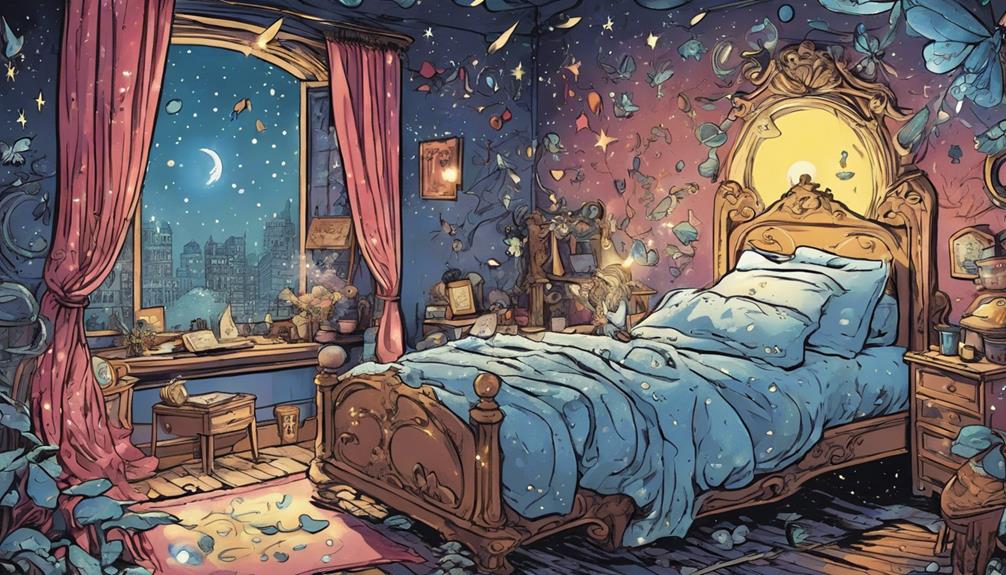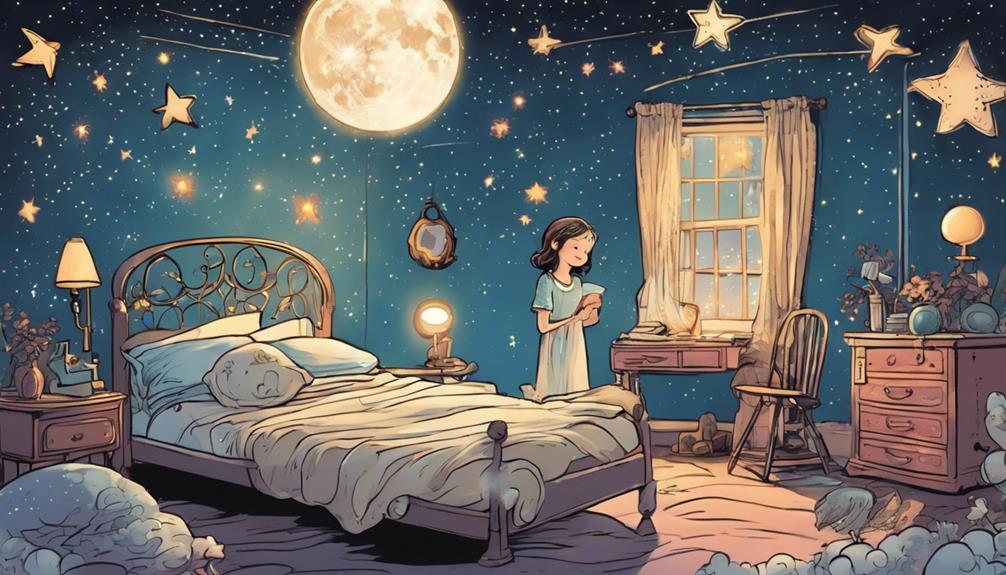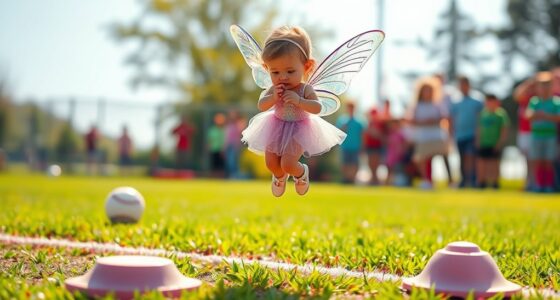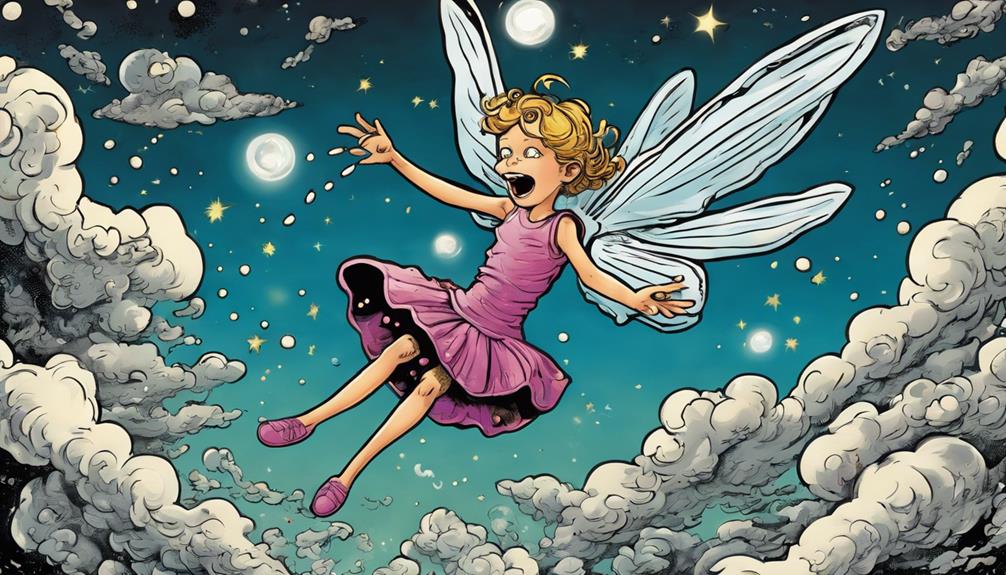The Tooth Fairy became a beloved legend by transforming the experience of losing teeth into a magical adventure. Originating from 18th-century French tales, she adapted and grew, engaging children in English-speaking cultures by the 1920s. This enchanting figure comforts kids and celebrates milestones, turning anxiety into joy. Various cultures embrace tooth-loss traditions, each adding unique twists. She's portrayed in literature and media, further embedding her in our hearts. As you look closer, you'll discover how her significance has evolved and the impact she's had on family traditions around the world.
Key Takeaways
- The Tooth Fairy originated from the 18th-century French tale of La Bonne Petite Souris, transforming tooth loss into a magical experience.
- Various cultures have unique tooth-loss traditions, enriching the Tooth Fairy's narrative and showcasing global diversity in childhood rituals.
- Post-World War II, the Tooth Fairy gained popularity in children's literature and media, reinforcing her magical qualities and family traditions.
- The Tooth Fairy provides comfort and excitement, helping children navigate the anxiety of losing teeth while fostering imagination and family bonds.
Origins of the Tooth Fairy

The Tooth Fairy's origins trace back to an 18th-century French tale where a mouse fairy collects teeth from under pillows. This enchanting character, known as La Bonne Petite Souris, began the Tooth Fairy myth that many children cherish today. The story transformed the sometimes intimidating experience of losing teeth into a magical adventure, fostering enthusiasm rather than fear.
As the tale made its way to English-speaking audiences in the 1920s, it gained popularity, becoming a comforting ritual for American families. The idea of a fairy exchanging teeth for coins helped to establish the Tooth Fairy as a symbol of childhood, representing innocence and wonder.
After World War II, the tradition flourished even more, as families embraced this whimsical figure during a time of economic prosperity. Children enthusiastically anticipated the arrival of the Tooth Fairy, looking forward to finding surprises under their pillows. This delightful figure helped to ease the anxiety of losing baby teeth, reinforcing the idea that change can be magical.
The Tooth Fairy's journey from a French tale to a beloved childhood icon showcases the power of storytelling and tradition in shaping our experiences.
Tooth-Loss Traditions Across Cultures

Many cultures have their own unique customs for what to do with baby teeth, reflecting a rich tapestry of beliefs and practices surrounding this milestone in childhood.
For instance, in parts of Europe and the Americas, children offer their lost teeth to mice, hoping to promote strong, healthy teeth in the future. Meanwhile, certain Indian tribes believe planting lost teeth in sacred spots brings luck and encourages the growth of permanent teeth.
In Tibetan tradition, you might find that crushed teeth are scattered in the wind, symbolizing a respectful passage to adulthood. Norse cultures, on the other hand, bury teeth to prevent difficulties in the afterlife, showcasing the profound significance of teeth in their rites of passage.
Across the globe, variations in tooth disposal rituals can include tossing teeth into the sun or fire, hiding them from animals, or placing them in mouse holes or trees. Each of these practices highlights a cultural connection to the legend of the Tooth Fairy, illustrating how different societies celebrate and honor the journey of losing baby teeth.
Evolution in Literature and Media

You might find it fascinating how the Tooth Fairy evolved from early folklore to a beloved character in modern media.
After gaining traction in the 1920s and surging in popularity post-World War II, her image became entrenched in American culture.
Today, films and stories continue to reshape her narrative, reflecting contemporary values and interests.
Early Folklore Influence
Evolving from the 18th-century French tale 'La Bonne Petite Souris,' the Tooth Fairy concept gained popularity in English literature during the 1920s, marking a significant shift in how this whimsical figure was perceived. Initially, the story featured a mouse fairy that transformed into a powerful entity, interacting with a king's teeth. This narrative served as a foundation for what would become a beloved character in English-speaking cultures.
As the Tooth Fairy took center stage in children's stories, her character evolved from a mouse to a charming fairy who rewards children for their lost teeth. This transformation established a historical connection between folklore and modern traditions. The narrative's shift emphasized the idea that losing a tooth could be an exciting event, rather than a source of fear.
In literature, stories began to portray the Tooth Fairy as a benevolent figure, reinforcing her role in family traditions. This portrayal laid the groundwork for the Tooth Fairy's enduring legacy, showcasing how early folklore influenced cultural perceptions.
Post-War Popularity Surge
After World War II, the Tooth Fairy became an increasingly cherished figure in children's literature and media, enchanting the imaginations of families across America. As prosperity surged in the post-World War II era, families found themselves more financially equipped to adopt the tradition of rewarding their children for lost teeth. This newfound ability to celebrate such milestones solidified the Tooth Fairy's role in childhood.
In the 1950s, media representations flourished, with films and television shows featuring good fairy characters that echoed the Tooth Fairy's magical qualities. These portrayals reinforced her image, making her an integral part of American culture. Children's literature also embraced the Tooth Fairy, creating stories that depicted her as a kind and whimsical figure, further captivating young audiences.
The Tooth Fairy's popularity wasn't just limited to stories; it also inspired creativity in various forms of media. The establishment of the Tooth Fairy Museum in Deerfield, Illinois, showcased the character's influence in art and literature. All these factors contributed to the Tooth Fairy evolving into a beloved cultural icon, enchanting children's imaginations and enriching family traditions across the nation.
Modern Media Representation
Modern media frequently reimagines the Tooth Fairy, transforming her from a simple folklore figure into a dynamic character that resonates with today's audiences. In her modern-day version, she offers comfort to children, making the tooth-losing experience exciting rather than intimidating. This evolution began in the 1920s but gained momentum in the post-World War II era, where her presence in literature and films solidified her status as a beloved cultural icon.
Films like 'Rise of the Guardians' and 'The Tooth Fairy' depict her in various roles, showcasing her as a guardian and a whimsical character. These portrayals highlight her adaptability, illustrating how media representation has shaped her narrative over the decades. The establishment of the Tooth Fairy Museum from 1993 to 2000 further emphasized her impact on popular culture, displaying the art and literature surrounding her.
Today, the Tooth Fairy continues to evolve, reflecting contemporary values and interests. She not only symbolizes the shift from childhood to adolescence but also brings joy and anticipation to children during a transformative moment in their lives. The ongoing reimagining in media guarantees her relevance for future generations.
Cultural Significance of the Tooth Fairy

The Tooth Fairy brings a sense of comfort and magic to kids as they lose their baby teeth, transforming what could be a scary moment into a fun and rewarding experience.
Around the world, different cultures have their own unique tooth disposal traditions, showing how this theme of childhood innocence resonates globally.
Childhood Comfort and Magic
Embodying childhood wonder, the Tooth Fairy transforms the anxiety of losing baby teeth into a cherished ritual filled with magic and comfort. When a child loses a tooth, this experience often mingles discomfort with excitement, creating memorable moments for families. The anticipation of finding a reward under the pillow nurtures imagination and reinforces innocence.
| Aspect | Description | Impact on Children |
|---|---|---|
| Ritual | Leaving the tooth under the pillow | Creates a sense of mystery |
| Reward | Gifts or money received | Encourages bravery and coping skills |
| Tradition | Shared across cultures | Strengthens family bonds |
| Imagination | Engaging with a magical narrative | Fosters creativity and hope |
This tradition not only offers comfort but also enriches childhood development. As children navigate the changes of growing up, the Tooth Fairy stands as a comforting figure, guiding them through these milestones with joy. By celebrating each lost tooth, families create lasting memories and foster open discussions about growth and change, solidifying the Tooth Fairy's role in childhood magic.
Global Tooth Traditions
Across the globe, cultures celebrate the loss of baby teeth with unique traditions that highlight the significance of this childhood milestone. While the Tooth Fairy reigns in many Western cultures, other customs add vibrant layers to this rite of passage.
For instance, in Latin cultures, you'll meet Ratoncito Perez, a little mouse who takes on the Tooth Fairy's role, rewarding kids for their lost teeth. This character emphasizes the universal theme of moving from childhood to adulthood while bringing joy to children.
In northern Europe, children often receive gifts upon losing their sixth tooth, reflecting its importance. Meanwhile, some Indian tribes have practices that involve planting baby teeth in sacred places to invite good luck. In Tibet, kids might scatter crushed teeth in the wind, symbolizing freedom and growth.
These global tooth traditions, from the enchanting tale of 'La Bonne Petite Souris' in France to various other customs, showcase how cultures adapt the concept of losing baby teeth. Ultimately, whether it's a tooth fairy or a lucky mouse, these traditions create magical moments that celebrate childhood innocence and imagination.
Impact on Family Dynamics

Tooth Fairy traditions create cherished moments that strengthen family bonds as parents and children share in the excitement of losing a tooth. This magical experience isn't just about the exchange of a lost tooth for a small reward; it opens the door to meaningful conversations about growth and change. You help your child navigate the anxieties that often accompany losing baby teeth, reinforcing feelings of security and emotional well-being.
Participating in the Tooth Fairy ritual also encourages imaginative play. You get to engage your child's creativity, transforming a simple act into a storytelling adventure. Whether you leave a whimsical note from the Tooth Fairy or come up with a story about her travels, you enhance your child's imaginative skills while fostering a deeper connection.
Moreover, the financial aspect of the Tooth Fairy tradition reflects evolving family dynamics. As children receive an average of $3.70 per lost tooth, it highlights the importance of celebrating bravery during childhood milestones. This practice not only nurtures your child's spirit but also reinforces values of support and encouragement within the family unit, making each tooth loss a special event worth remembering.
Global Variations of the Tradition

In many cultures around the world, traditions surrounding lost teeth vary widely, showcasing unique customs that celebrate this childhood milestone.
In the United States, you know the Tooth Fairy as a benevolent figure who exchanges money or gifts for lost teeth. However, in France, you might encounter La Petite Souris, a charming mouse or rabbit character who performs a similar role, highlighting the significance of animals in these traditions since the 17th century.
Meanwhile, in many Latin American countries, Ratoncito Perez takes the stage. This beloved mouse not only collects lost teeth but also has a dedicated museum in Madrid, Spain, where his cultural importance is celebrated.
In India, some tribes have a distinct approach; they plant lost teeth in sacred places, believing it fosters luck and encourages healthy growth of permanent teeth.
Across the globe, the concept of the Tooth Fairy adapts beautifully. You might find variations that feature beavers, cats, or squirrels, showcasing how the tradition can transform while still honoring the joy of losing a tooth.
Each variation reflects local culture, making this rite of passage a truly global phenomenon.
The Tooth Fairy in Popular Culture

The Tooth Fairy has not only captivated children through various global traditions but has also carved out a significant place in popular culture, appearing in films, books, and even museums that celebrate her legacy. You'll find her in delightful children's books that help ease the anxiety of losing baby teeth, reinforcing her role as a comforting figure.
Interestingly, the Tooth Fairy's character spans various genres, from the whimsical portrayal in "Rise of the Guardians" to the darker reimagining in "Darkness Falls." This versatility showcases her adaptability in modern storytelling. The establishment of the Tooth Fairy Museum in Deerfield, Illinois, from 1993 to 2000 served to highlight her cultural significance, featuring artistic representations that captivated visitors.
Here's a quick overview of her presence in popular culture:
| Medium | Examples |
|---|---|
| Films | "Rise of the Guardians," "The Tooth Fairy" |
| Children's Books | "The Tooth Fairy's Journey," "The Tooth Fairy's Secret" |
| Museums | Tooth Fairy Museum, Deerfield, IL |
| Horror Adaptations | "Darkness Falls" |
Through these forms of media, the Tooth Fairy continues to evolve and inspire, maintaining her cherished place in childhood experiences.
Modern Relevance and Adaptations

Many families today still embrace the Tooth Fairy tradition, adapting it in creative ways that enhance children's dental experiences while keeping the magic alive. In modern-day America, the Tooth Fairy remains a beloved figure, with families averaging a compensation of $3.70 for lost teeth, signifying the tradition's evolving significance.
Dental practices, like MINT dentistry, cleverly incorporate Tooth Fairy themes into their marketing strategies, engaging kids and promoting the importance of dental products. This not only makes dental visits more enjoyable but also reinforces good oral hygiene habits.
The American Dental Association supports this ongoing relevance through initiatives like the 'Ask the Tooth Fairy' advice column, where children can receive dental care tips directly from their favorite fairy. During the COVID-19 pandemic, the tradition evolved further with innovations like the Tooth Fairy Hotline, allowing parents to text messages to keep the enchantment alive.
Ultimately, the Tooth Fairy tradition symbolizes the shift from childhood to adolescence, providing a comforting experience that inspires imaginative play. By blending tradition with modern relevance, families continue to celebrate the magic of the Tooth Fairy in new and exciting ways.
Frequently Asked Questions
How Did the Legend of the Tooth Fairy Start?
The legend of the Tooth Fairy started with European folklore, particularly tales involving mice helping children. Over time, it evolved into a comforting figure, especially in American culture, symbolizing childhood and the loss of baby teeth.
What Is the Tooth Fairy Urban Legend?
The Tooth Fairy urban legend delights kids, with families typically leaving an average of $3.70 per tooth. She's a magical figure who exchanges lost teeth for gifts, fostering creativity and joy in childhood traditions.
What Is the Dark Story Behind the Tooth Fairy?
You might be surprised to learn that the Tooth Fairy's origins include darker tales, like a mouse fairy knocking out a king's teeth. These stories reflect themes of violence and superstition, evolving into a more comforting folklore.
What's the Point of the Tooth Fairy?
The Tooth Fairy's purpose is to ease your child's anxiety about losing teeth. She turns a scary moment into a fun tradition, sparking excitement and imagination while rewarding the milestone of growing up.
Conclusion
As you tuck your child in at night, the magic of the Tooth Fairy dances between reality and myth.
In a world where technology reigns, the simple act of exchanging a lost tooth for a coin bridges generations.
You see their wide-eyed wonder, a stark contrast to the everyday grind of life.
This enchanting figure not only celebrates milestones but also strengthens family bonds, reminding us all that even in our fast-paced lives, a little magic still exists.









